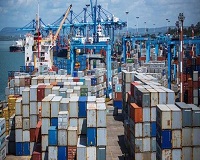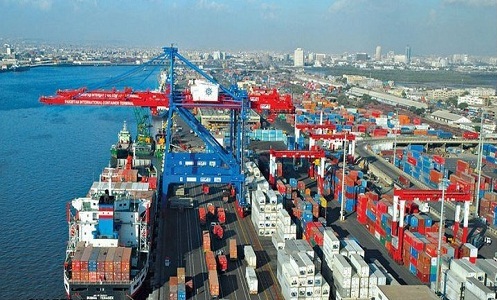"Pakistan has consistently got low rankings on Global Competitiveness Index. It ranked 115 out of 137 economies for 2017-18, compared with India (40), Iran (69), Sri Lanka (65), and Bangladesh (99). Pakistan needs to amplify exports competitiveness just the same way as East Asian economies, such as South Korea, Taiwan, Singapore and Hong Kong, successfully implemented export-led growth strategies. As per World Bank data, Chinese exports went up from $62.09 billion in 1990 to $2,097 billion in 2016, an average annual growth of 15.32 per cent. During the same period, the Chinese economy grew an average 9.63 per cent. Indian exports went up from $17.96 billion in 1990 to $264.40 billion in 2016 up by 11.82 per cent a year while Indian economy grew on average 6.59 per cent (World Bank data)."
 Pakistan has consistently got low rankings on Global Competitiveness Index. It ranked 115 out of 137 economies for 2017-18, compared with India (40), Iran (69), Sri Lanka (65), and Bangladesh (99). Pakistan needs to amplify exports competitiveness just the same way as East Asian economies, such as South Korea, Taiwan, Singapore and Hong Kong, successfully implemented export-led growth strategies. As per World Bank data, Chinese exports went up from $62.09 billion in 1990 to $2,097 billion in 2016, an average annual growth of 15.32 per cent. During the same period, the Chinese economy grew an average 9.63 per cent. Indian exports went up from $17.96 billion in 1990 to $264.40 billion in 2016 up by 11.82 per cent a year while Indian economy grew on average 6.59 per cent (World Bank data). Between 1990-91 and 2016-17, Pakistan’s exports went up from $5.61 billion to $20.43 billion. Thus, in both these countries, high economic growth was reinforced by robust export growth. On the contrary, the Pakistani economy grew on average 4.5 per cent. During the 1990s, GDP grew 4.6 per cent a year. During the 2000s, the average economic growth marginally went up to 4.7 per cent. Between 2010-11 and 2016-17, economic growth decelerated to 4.3 per cent, according to the Pakistan Economic Survey data.
Pakistan has consistently got low rankings on Global Competitiveness Index. It ranked 115 out of 137 economies for 2017-18, compared with India (40), Iran (69), Sri Lanka (65), and Bangladesh (99). Pakistan needs to amplify exports competitiveness just the same way as East Asian economies, such as South Korea, Taiwan, Singapore and Hong Kong, successfully implemented export-led growth strategies. As per World Bank data, Chinese exports went up from $62.09 billion in 1990 to $2,097 billion in 2016, an average annual growth of 15.32 per cent. During the same period, the Chinese economy grew an average 9.63 per cent. Indian exports went up from $17.96 billion in 1990 to $264.40 billion in 2016 up by 11.82 per cent a year while Indian economy grew on average 6.59 per cent (World Bank data). Between 1990-91 and 2016-17, Pakistan’s exports went up from $5.61 billion to $20.43 billion. Thus, in both these countries, high economic growth was reinforced by robust export growth. On the contrary, the Pakistani economy grew on average 4.5 per cent. During the 1990s, GDP grew 4.6 per cent a year. During the 2000s, the average economic growth marginally went up to 4.7 per cent. Between 2010-11 and 2016-17, economic growth decelerated to 4.3 per cent, according to the Pakistan Economic Survey data.
The figure clearly shows Pakistan’s export-to-GDP ratio has come down from 15.53 per cent in 1990 to 9.13 per cent in 2016. As per World Bank data, during the 1990s, Pakistan’s average export-to-GDP ratio was 16.4 per cent, which fell to 14.35 per cent during the 2000s. Since 2010, the average export-to-GDP ratio has come down to 12.16 per cent. Pakistan’s current export-to-GDP ratio of 9.13 per cent is among the lowest in the region: Iran (22.40 per cent), China (19.64 per cent), India (19.17 per cent), Sri Lanka (21.44 per cent) and Bangladesh (16.64 per cent).
cent in 2016. As per World Bank data, during the 1990s, Pakistan’s average export-to-GDP ratio was 16.4 per cent, which fell to 14.35 per cent during the 2000s. Since 2010, the average export-to-GDP ratio has come down to 12.16 per cent. Pakistan’s current export-to-GDP ratio of 9.13 per cent is among the lowest in the region: Iran (22.40 per cent), China (19.64 per cent), India (19.17 per cent), Sri Lanka (21.44 per cent) and Bangladesh (16.64 per cent).
Implications on the country
Experts say, higher productivity means not only producing more output from the given resources but also producing products, which better satisfy customer needs. Export-led growth process must include decreasing dependence on traditional exports and increasing dependence on value-added manufactures, particularly those which have a high growth potential in international market. Having said that without improvement in productivity exports will find it difficult to successfully compete in foreign markets both in terms of price and quality. If the production function in exporting enterprises is not better than that in the enterprises producing for the domestic market, the export sector cannot serve as a catalyst for development.
Pakistan Economic Survey highlighted in 1989-90, the percentage share of primary products, semi manufactures, and manufactures in total exports was 20, 24, and 56 respectively. By the end of 2016-17, export composition had changed as follows: primary products 15 per cent, semi manufactures 12 per cent and manufactures 73 per cent. Although the share of the manufactured goods in total export basket has considerably gone up, the export of manufactured products is heavily dominated by commodity-based manufactures. In 2016-17, the share of textiles and clothing (T&C) in total export of manufactures was 67.21 per cent, followed by 3.94 per cent share of the leather sector.
Pakistan’s share in global textiles and clothing exports is only 1.83 per cent. On the other hand, the engineering sector, which accounts for nearly 60 per cent of global trade, accounts for merely 1.17 per cent of Pakistan’s total exports. The share of engineering products in total exports of China and India is 47 per cent and 23 per cent respectively.
Replacing handlooms with state-of-the art machinery will help the country gain significance globally. More than that, it’s the presence of entrepreneurship, which would aid in professional management, labour training, diffusion of decision-making within the enterprise, risk taking by venturing into new areas, or at least, experimenting with product design, and a total commitment to quality.












